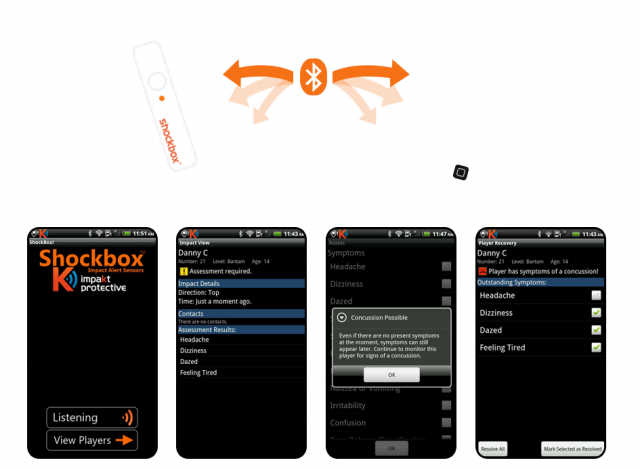Shockbox Helmet Sensor: A Concussion Alert System
One of the biggest challenges in the battle against sports concussion is knowing when to conduct an initial assessment. Depending on athletes to admit to experiencing concussion symptoms doesn't work due to chronic under-reporting.1 Likewise, studies show that coaches and athletic trainers can't be counted on to reliably identify athletes exhibiting signs of possible concussion for screening on the sports sidelines, especially since only 5 to 10% of concussions involve a loss of consciousness and the onset of concussions symptoms is often delayed, especially in younger athletes.
In most cases, athletes immediately removed from contact or collision sports after suffering a concussion will recover without incident fairly quickly (seven to ten days), but if they are allowed to keep playing, their recovery is likely to take longer, and they are at increased risk of long-term problems, and even catastrophic injury or death.
Wouldn't it be great if we didn't have to rely on the athletes themselves, game officials, or even sideline observers to call for a concussion assessment; if there was, in essence, an "eye in the sky" or early warning system that would set off an alarm whenever an athlete suffered a blow to the head - or a hit to another body part where the force is transmitted to the head - hard enough to cause possible concussion so that the player could be immediately removed from the game or practice to be evaluated?
Well, now there is.
Combat tested
Using technology developed for use by the U.S. military in combat helmets as a springboard, a Canadian company, Impakt Protective Inc., recently introduced a revolutionary head impact sensor called ShockboxTM. Installed in a player's helmet, the sensor triggers an alert on a smart phone any time a player suffers an "at risk" hit that may be concussive.
The brainchild of Danny Crossman, a British bomb disposal officer responsible for such lifesaving technologies as the bomb suit featured in the OscarTM-winning movie, The Hurt Locker, ShockboxTM consists of a miniature sensor with rechargeable battery, BluetoothTM wireless module and a sensor, which transmits data on hits to a player's helmet in real time to a smartphone, laptop or PDA on which the Shockbox app has been downloaded.

When the app identifies a hit which may cause traumatic brain injury, an audible and visual, color-coded visual alert (yellow, orange, or red) is triggered on the user's device so that an assessment for possible concussion can begin immediately on the sports sideline using a standard assessment tool (e.g. SCAT2) or the concussion symptom checklist displayed on the smart-phone.
A single smart-phone can monitor an entire team (up to 128 players) simultaneously from distances up to 325 feet, recording impact date, time, hit direction, and force for each player using a unique serial number. Data can also be sent via e-mail or SMS to the phone of an athletic trainer, doctor or parent and pushed anonymously to Impakt to help it refine the product.
A version for hockey helmets is now available for Android, iPhone and Blackberry smartphones. It regularly sells for $199 but Impakt is running a 2 for $199 special through the end of 2011). A model for ski and snowboard helmet is scheduled for launch in the winter of 2011-2012, and football and lacrosse models are expected to be available next year.
Value seen
"So far, based on the 300 to 400 interviews we have conducted, athletic trainers like the triage approach we have taken with the color-coded alerts, and the vast majority see value in the ShockboxTM," Crossman said. He admits, though, that the success of the technology hinges on acceptance. The ShockboxTM technology has to follow the sports culture, otherwise it will not get used by players or teams. By integrating the sensor as a wireless system that communicates directly with off-the-shelf smart phones or PC's, teams can use it the way that best suits their needs.
The use of ShockboxTM is likely to be especially valuable at the youth and middle school level, where coaches either lack the training necessary to detect concussions or, because of the warrior and win-at-all-costs mentality that pervades the culture of such sports, are reluctant to remove a player with suspected concussion from game action.
He sees ShockboxTM as having value for parents and sideline personnel, albeit for different reasons. Parents will like ShockboxTM, Crossman believes, because if they get an alert on their phone, they may be more likely to say to a coach or athletic trainer, ‘Check him out', even if the coach or trainer might not be inclined to do so. The advantage of Shockbox for athletic trainers and coaches, he says, is that they can use it to take an athlete out of game action for an assessment "even if a parent wants their child to keep playing."
Not a silver bullet
Crossman emphasizes that ShockboxTM won't make helmets safer or reduce the number of concussions.
"Injury assessment is a fickle science due to the variances of individual brain physiology, concussion history and so on, and for this reason, ShockboxTM does not attempt to assess an injury in the player; that is a sports physician's job."
The bottom line, as Crossman says, is ShockboxTM is "another tool in the concussion toolbox, [but] just one of many, because there's never going to be a silver bullet in this business."
1. Williamson J, Goodman D. Converging evidence for the under-reporting of concussions in youth ice hockey. Br J Sports Med 2006;40:128-132 .
Posted December 21, 2011
- 15205 reads
- Flag as offensive
- Printer-friendly version








